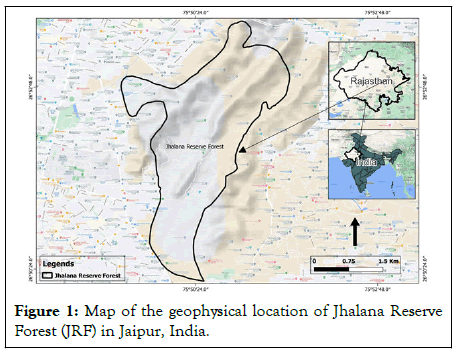Poultry, Fisheries & Wildlife Sciences
Open Access
ISSN: 2375-446X
ISSN: 2375-446X
Short Communication - (2023)Volume 11, Issue 1
Exponential growth in the human population, expeditious urbanization, and rapid development of infrastructure and transportation networks has resulted in a substantial increase in anthropogenic noise, thereby recasting tellurian soundscapes [1]. Increased levels of anthropogenic noise impact the behavior, physiology, recruitment, and fitness of the avifauna, in humandominated terrestrial and aquatic ecosystems [2]. Jhalana Reserve Forest (JRF) has the characteristics of island biogeography in the heart of the city of Jaipur, in northwest India. With an area of 29 km2, this reserve is engulfed by a human population of 3.9 million on the west flank, two major national highways on the east flank, and 18 villages hosting a human population of 80,000 and six religious institutions on the north and south periphery (Figure 1).

Figure 1: Map of the geophysical location of Jhalana Reserve Forest (JRF) in Jaipur, India.
The anthropogenic noise is escalated by year-round activities at various religious centers, festivals, and cultural events. JRF hosts a population of 31 leopards (Panthera pardus fusca) thereby making Jaipur the leopard capital of India [3]. Wildlife safaris in JRF are a major source of income for local guides and safari drivers, and other tourist related facilities like eateries and hotels.
Non-Electric Off-Road Vehicles (ORVs) are universally used for wildlife safaris in ecotourism zones worldwide including India [4]. Out of the 16 vehicles used for wildlife safaris in JRF, 10 are petrol-fuelled (Maruti Gypsy) and six are electric vehicles (Mahindra ESUPRO E-VEHICLE). Tourists are driven to the core area twice a day with leopards as the focal species [5]. As a result of species-centric tourism, a lot of vehicular traffic is reported around the focal species (leopard), thereby resulting in enhanced noise levels due to the racing of vehicles and revving of the engines [6]. As a consequence, a variety of species like Nilgai (Boselaphus tragocamelus), Indian Peafowl (Pavo cristatus), Chital (Axis axis), etc. are equally affected. We hypothesized that as compared to the non-electric ORVs the e-vehicles would facilitate a closer approach to wildlife, reducing the fight initiation distance (FID) to their normal behavior patterns. We used a mixed model approach to evaluate the effects of noise generated by electric and non-electric vehicles on the birds and mammals of JRF [7].
We used a cell phone (Samsung S9) along with a “Sound Meter” application downloaded from Google Play Store to measure the decibel levels of both types of vehicles in idling and revving conditions [8]. To record the effects of the vehicles on the wildlife, we drove it in the vehicles at a speed of 20km/h, and it used 8 × 36 Bushnell yardage pro binoculars to evaluate the Flight Initiation Distance (FID), the distance at which individuals escape when approached by the vehicle [9,10].
As hypothesized, our results implied that e-vehicles allowed for a closer approach, FIDs were shortened for e-vehicles and they caused fewer disturbances as compared to non-electric ORVs. The results were heterogeneous for birds versus mammals. We assume that the FIDs will be further shortened if the vehicles were to be driven at a slower, constant speed without revving of engines.
Few studies have been carried out to understand how the intrinsic and extrinsic characteristics are affected as a result of response to the environmental stress factors caused by the increasing noise. Our study further facilitates a deeper understanding of the impact of anthropogenic noise on behavioral and morphological aspects such as foraging, hindering vocal communication, parental care, antipredator responses, induced stress, and impaired hearing capacities, injuries due to vehicular collision, fitness, and recruitment [11].
Strategies to reduce stress on wildlife can be designed and implemented with results from further similar studies. We eulogize this innovative initiative successfully implemented by the Rajasthan Forest Department Service. It’s an example set for the remaining states in India and authorities all over the world to study and implement a similar model in their respective conservancies. Our study implies that electric vehicles can replace the existing ORVs for a better experience for tourists and reduced stress on the wildlife in this human-dominated landscape.
Citation: Kumbhojkar S, Yosef R (2023) Impact of Electrical Vehicles on the Behavioural Response of Wildlife. Poult Fish Wildl Sci.11:230
Received: 03-Feb-2023, Manuscript No. PFW-23-21527; Editor assigned: 06-Feb-2023, Pre QC No. PFW-23-21527 (PQ); Reviewed: 20-Feb-2023, QC No. PFW-23-21527; Revised: 27-Feb-2023, Manuscript No. PFW-23-21527 (R); Published: 06-Mar-2023 , DOI: 10.35248/2375-446X.23.11.230
Copyright: © 2023 Kumbhojkar S, et al. This is an open-access article distributed under the terms of the Creative Commons Attribution License, which permits unrestricted use, distribution, and reproduction in any medium, provided the original author and source are credited.